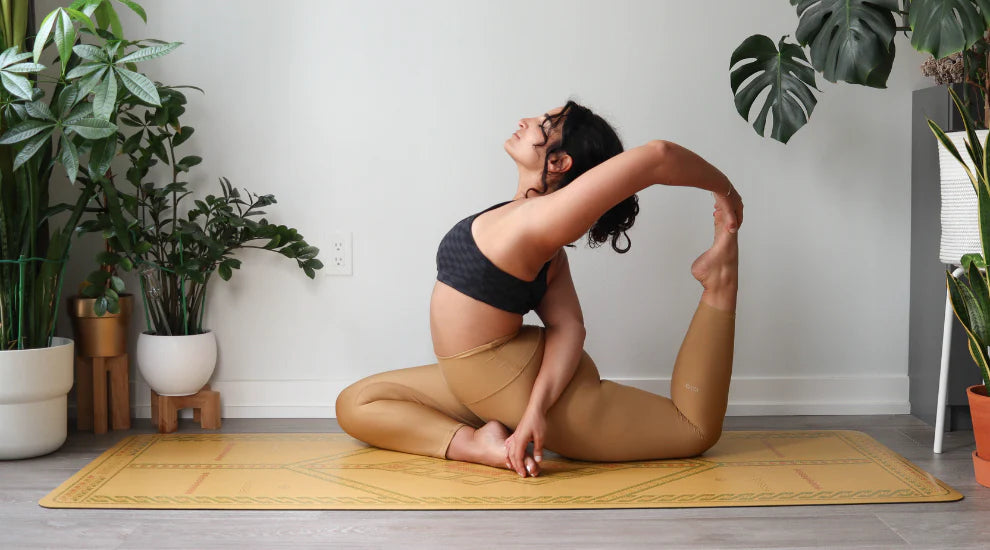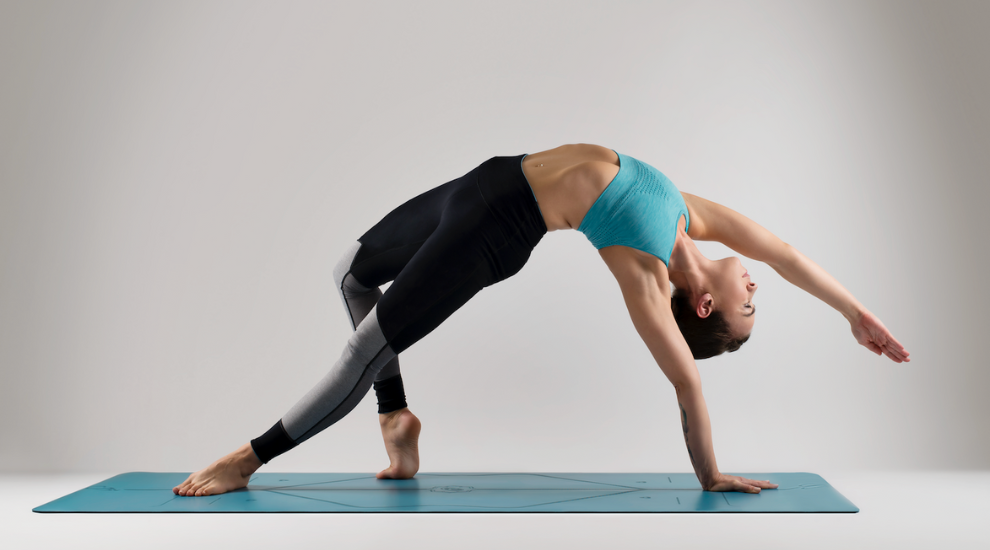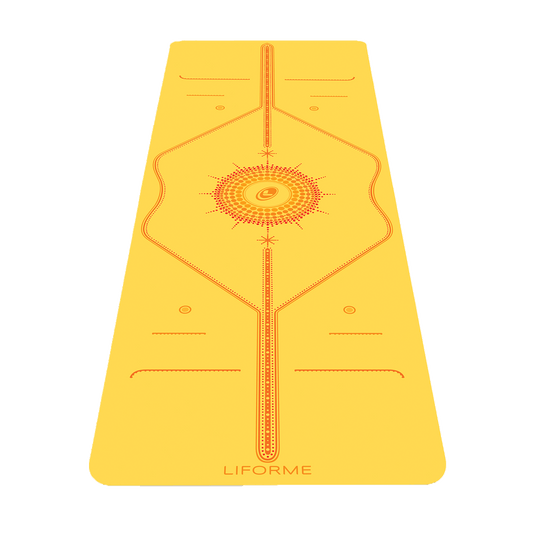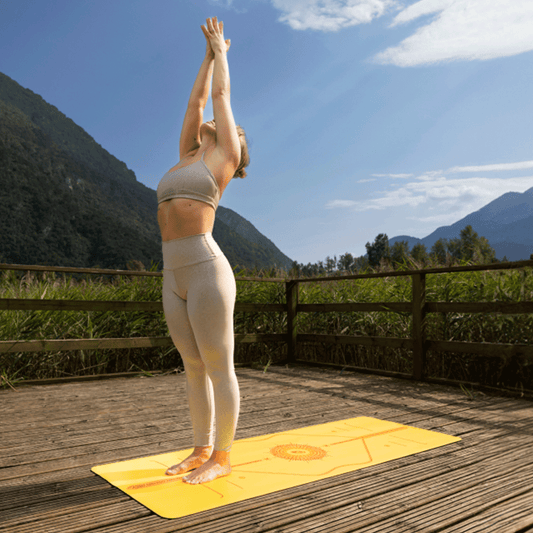Yoga heart openers are poses that expand your upper chest and rib cage to release tension from your shoulders, neck, and back. These poses are particularly valuable to those of us who spend a lot of time hunching over screens (also known as all of us). Constantly rounding your spine and neck forward is not only bad for your posture, it affects how you relate to the world around you. Stretching your back and opening your heart allow you to stand straighter and be more receptive and engaged.
Heart Opening vs. Back Bending
You may notice that the poses we’re calling heart openers could just as accurately be called backbends. We’re not trying to pull the wool over your eyes: they are, in fact, a very similar set of poses. So why does it matter what we call them? Because the terminology we use indicates a subtle difference in approach.
Back bending puts the emphasis on the mobility of the spine. Since most people are most flexible in their lumbar spines, that’s where the curve goes when you ask your spine to move into extension. It takes a concerted effort to work on the rest of your spine, particularly the upper back, which is behind the heart. (For yoga purposes, assume the heart is on your sternum.)
When you call the pose a heart opener, you’ve gotten your chest, ribs, scapula, and shoulders into the action, in addition to activating your thoracic spine. As you move into intermediate and advanced backbends, it’s key to think of your shoulder blades as the support system for your heart, which helps make more space for your spinal extension and takes pressure off your low back.
Sphinx Pose (Salamba Bhujangasana)
Sanskrit Meaning: Salamba (Supported) Bhujanga (Cobra)
Yoga Level: Beginner
Benefits: A gentle way to get the feel for heart opening
Step-by-Step:
1. Come to lie on your stomach.
2. Come up to your elbows with your forearms parallel and your elbows directly under your shoulders.
3. Draw your shoulders down and back.
4. Press in your forearms and palms to externally rotate your upper arms and lift your sternum.
5. Look for this feeling in your other heart-opening poses.
Cat/Cow (Marjaryasana-Bitilasana)
Sanskrit Meaning: Marjary (Cat) Bitil (Cow)
Yoga Level: Beginner
Benefits: Moving in and out of an open-heated position improves your body awareness
Step-by-Step:
1. Come onto all fours with your spine in a neutral position.
2. Bend your elbows slightly.
3. On an inhalation, lift your tail, drop your belly while keeping the navel toward your spine, open your chest toward the front of the room, and lift your gaze toward the ceiling.
4. On your next exhalation, drop your tail, dome your spine, and take your gaze to your navel.
5. Repeat for several breath cycles feeling how softening your elbows facilitates opening your chest.
Puppy Pose (Uttana Shishosana)
Sanskrit Meaning: Uttana (Intense) Shisho (Puppy)
Yoga Level: Beginner
Benefits: Most heart openers are done with the chest facing upwards. Puppy flips that script.
Step-by-Step:
1. Come to your hands and knees with your hips stacked over your knees and your shoulders stacked over your wrists.
2. Keeping your hips over your knees as you begin to walk your hands forward.
3. Come forward to your fullest extension, which could be forehead to the mat, chin to the mat, or chest to the mat.
Upward Facing Dog Pose (Urdhva Mukha Svanasana)
Sanskrit Meaning: Urdhva (Upward) Mukha (Facing) Svana (Dog)
Yoga Level: Intermediate
Benefits: Improves arm and shoulder strength. Opens the chest and back.
Step-by-Step:
1. From Cobra Pose, press into your palms to straighten your arms.
2. Continue putting pressure into your hands to draw your shoulders down away from your ears.
3. Press into the tops of your feet to lift your legs off the floor.
4. If you bend your elbows, it’s easier to roll your shoulders back and down and puff up your chest. If straightening your arms undoes this work, keep the elbows slightly bent throughout the pose.
5. Lift your gaze but keep your neck in a neutral position.
Camel Pose (Ustrasana)
Sanskrit Meaning: Ustra (Camel)
Yoga Level: Beginner
Benefits: Strengthens and stretches your core and back. Opens your abdominals, chest, and throat.
Step-by-Step:
1. Come to a kneeling position with your hips over your knees. Take a Yoga Pad under your knees for additional cushioning.
2. Roll your shoulders up and then down and back so that your shoulder blades hug your back.
3. Bring the palms of your hands (with fingers pointing down) onto your sacrum and move your elbows toward the middle of your back. This is a great version of Camel Pose. Opening the chest is the object here, not reaching your heels.
4. If you do decide to go for your heels, make sure your pelvis stays over your knees. There’s no point in taking your arms back if your hips go with them.
5. When you reach for your feet, your toes can be tucked under to raise the heels a bit or the tops of your feet can be flat on the floor to take it deeper. If neither of these work, blocks (at any level) on either side of your feet are another good choice.
6. You can really feel how your shoulder blades act as a little shelf for your heart here. Imagine that you’re trying to get some sunshine on your sternum.
Bow Pose (Dhanurasana)
Sanskrit Meaning: Dhanu (Bow)
Yoga Level: Intermediate
Benefits: The traction between your arms and legs creates a wonderful openness in the chest.
Step-by-Step:
1. Come to lie on your stomach.
2. Bend your knees so that the soles of your feet are facing the ceiling.
3. Reach your arms back and take hold of the outside of each ankle.
4. Keeping your feet flexed, on an inhalation kick into your feet to lift your chest away from the floor.
5. Stay for several breaths, letting each inhalation lift your chest.
Bridge Pose (Setu Bandhasana)
Sanskrit Meaning: Setu (Bridge) Bandha (Lock)
Yoga Level: Beginner
Benefits: Tucking your shoulders under allows for expansive heart opening.
Step-by-Step:
1. Lie on your back with your knees bent and feet flat on the floor close to your butt.
2. Bring your arms along your sides.
3. On an inhalation, press into your feet to lift your butt off the floor.
4. Use your glutes to lift your pelvis higher.
5. Roll your shoulders under one at a time.
6. Clasp your hands behind your back.
7. Lift your sternum and your hips.
Fish Pose (Matsyasana)
Sanskrit Meaning: Matsya (Fish)
Yoga Level: Beginner
Benefits: Another way to open your heart is by tucking your shoulders under and using your shoulder blades for support.
Step-by-Step:
1. Lie on your back with your arms alongside your body.
2. Bend your elbows and come up to your forearms.
3. Lift your sternum toward the ceiling as you arch your spine and lower the crown of your head to the floor.
4. Keep your legs and feet active.
5. After several breaths, press into your forearms to lift your head.
Wild Thing Pose (Camatkarasana)
Sanskrit Meaning: Camatkara (Wonder)
Yoga Level: Intermediate
Benefits: A chance to work on opening your chest toward the sky
Step-by-Step:
1. Begin by coming into Side Plank Pose with your right hand on the floor.
2. Lift your left leg, bend your knee, and drop the ball of your left foot behind your right knee.
3. Open your left arm 180 degrees as you turn your chest to face the ceiling.
4. Press into your right hand and both feet to lift your heart.
Wheel Pose (Urdhva Dhanurasana)
Sanskrit Meaning: Urdhva (Upward) Dhanu (Bow)
Yoga Level: Intermediate
Benefits: Strengthens your shoulders, glutes, and back. Opens your chest and front body.
Step-by-Step:
1. Lie on your back with your knees bent, feet parallel, and heels close to your butt.
2. Bend your elbows and bring your palms flat under your shoulders (or a little wider) with your wrist creases parallel to the back edge of the mat.
3. On an exhalation, push into your hands and feet to lift your hips toward the ceiling.
4. Make sure your feet are still parallel.
5. Picture your chest moving through your arms as you continue holding the shoulder blades on your back.
6. Let your head hang to release tension from your neck.
7. After a few breaths, tuck your chin before lowering back to the floor.
Crescent Lunge Pose (Anjaneyasana)
Sanskrit Meaning: Anjani (Hindu Goddess)
Yoga Level: Beginner
Benefits: There are many ways to approach Crescent Lunge. Here, we’re emphasizing the heart opening, of course.
Step-by-Step:
1. From Downward Facing Dog, step your right foot to the inside of your right hand and lower your left knee to the mat.
2. On an inhalation, lift your arms overhead.
3. Deepen the bend in your front knee, bringing your hips forward.
4. Reach your arms toward the back of the room and open your chest toward the ceiling. 
Reverse Warrior Pose
Also Known As: Peaceful Warrior Pose
Yoga Level: Beginner
Benefits: Improves leg strength. Opens the side body.
Step-by-Step:
1. Begin in Warrior II Pose with your right leg forward.
2. Reach your right arm forward, then arc it over your head.
3. Bring your left hand down the back of your left leg.
Sugarcane Pose (Ardha Chandra Chapasana)
Sanskrit Meaning: Ardha (Half) Chandra (Moon) Chapa (Bow)
Yoga Level: Intermediate
Benefits: Use the traction between your foot and hand to expand your chest.
Props: Use a block under your hand if you do in Half Moon Pose.
Step-by-Step:
1. Begin in Half Moon Pose standing on your right leg.
2. Bend your left leg, bringing your left heel close to your butt.
3. Reach your left hand behind your back and take hold of your left foot.
4. Kick your left foot away from your body and puff out your chest.
King Dancer Pose (Natarajasana)
Sanskrit Meaning: Nataraja (King Dancer)
Yoga Level: Intermediate
Benefits: Add a balance challenge to your heart opener.
Step-by-Step:
1. From Mountain Pose, transfer your weight into your right leg without shifting your hips.
2. Bend your left knee and bring your left heel close to your left buttock.
3. Reach your left hand back and take hold of the outside of your left foot.
4. Bring your right arm up straight toward the ceiling.
5. Keeping your right knee slightly bent, begin to bring your chest and right arm forward while kicking your left foot back.
6. Keep going until your left thigh is roughly parallel to the floor.
7. Use the traction between your left foot and left hand to open your chest.
Standing Backbend (Anuvittasana)
Sanskrit Meaning: Anuvitta (Found)
Yoga Level: Intermediate
Benefits: Improves balance and opens the front body.
Step-by-Step:
1. Come to stand in Mountain Pose
2. On an inhalation, lift your arms overhead.
3. Push your pelvis forward and begin to reach your chest toward the ceiling and your arms toward the back of the room.
Mermaid (Eka Pada Rajakapotasana)
Sanskrit Meaning: Eka (One) Pada (Foot) Raja (King) Kapota (Pigeon)
Yoga Level: Beginner
Benefits: This variation of Pigeon offers the opportunity to open your chest in a new way.
Step-by-Step:
1. Begin in Pigeon Prep Pose with your right leg forward.
2. Bend your left knee.
3. Reach back with your left hand and take hold of your left foot.
4. Bring your left foot into the crook of your left elbow.
5. Reach your right arm straight up to the ceiling.
6. Bend your right elbow and clasp your hands behind your head.
7. List your gaze and expand your chest.
Corpse Pose (Savasana)
Sanskrit Meaning: Sava (Corpse)
Yoga Level: Beginner
Benefits: A self-adjustment in Savasana gives you one last chance for a passive heart opener.
Step-by-Step:
1. Come to lie on your back with your arms by your sides.
2. Press into your elbows to lift your chest slightly
3. Roll your shoulders open, moving your shoulder blades onto your back and toward the midline of your spine.
4. Your forearms will widen and your palms naturally face up.
5. Observe the support that your scapulae are giving your chest and look for that sensation in your more active heart openers.
Bringing Heart Opening into Your Daily Life
Sitting at your desk, standing in line, waiting for the train. These might typically be times when you find that your spine is rounding forward. Training yourself to notice this is the first step. Once you are in a state of awareness, take the opportunity to instead roll your shoulders back, lift your head, and open your heart. Practice can soon become habit, and your neck will thank you!



















































